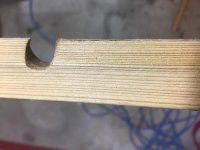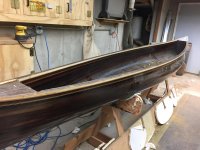The tape line worked well, minimal fraying of the cloth. After I cut it I had to go around the edge with a brush to do a little touch up which went well. I think I put the second football layer on top mostly out of habit. When I do it in the outside of the hill I can scrape the edge to make a smooth transition without compromising the full layer.
If I reversed it the only thing I could do is add epoxy to smooth the transition which I don't like to do.
For the inside though I don't really work too hard to make it perfect so I doubt I would sand through the full layer when cleaning it up. It probably would have been fine doing it as you suggested.
If I reversed it the only thing I could do is add epoxy to smooth the transition which I don't like to do.
For the inside though I don't really work too hard to make it perfect so I doubt I would sand through the full layer when cleaning it up. It probably would have been fine doing it as you suggested.




